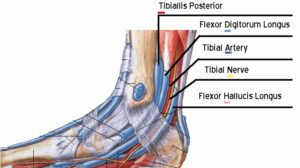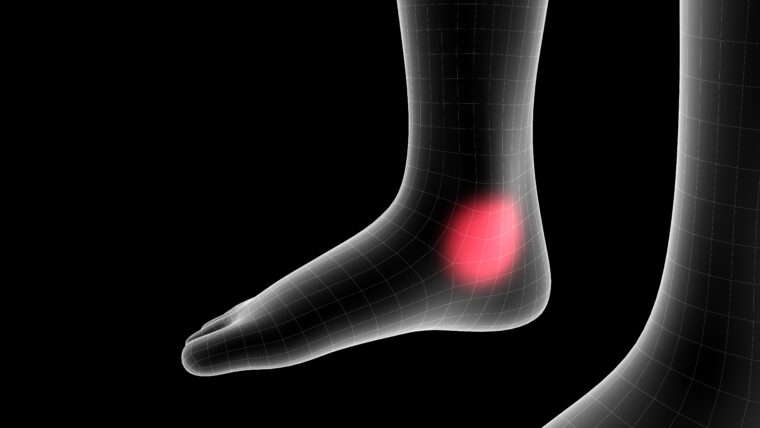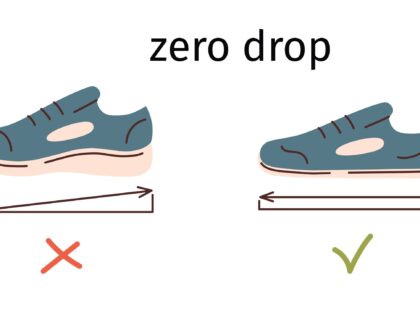We previously discussed when we turn our ankle in…now we need to look at when we turn it the other way.
Turning the ankle out does not occur as much as when we turn the ankle in. In fact, data show this happens between 5-10% of the time. We do see a lot more lateral ankle sprains, but we must be aware of medial ankle sprains and what to do with them. Why are there more lateral ankle sprains? Simply put, it’s a lot more unstable on the lateral side than the medial side. On the medial side, we have more ligaments, a larger weight bearing bone, ideally a proper arch, that even if reduced, helps support the medial side.
This begs the question: If it’s so much more stable, how can it turn outward? Generally speaking, this form of ankle sprain occurs more often when there is contact with another athlete. It also occurs when we are cutting/moving and the foot gets planted in the ground and our body goes across it. This can flatten out the arch and create a nasty valgus (ankle in, foot turns out) stress. This creates stress on the inside of the ankle as the body rolls over it, thus causing injury.
Please subscribe to our YouTube channel to stay informed of all new educational videos

The medial ankle and its 4 ligaments that form what are called the Deltoid Ligament.
The medial ankle has 4 stabilizing ligaments and several muscles. These structures not only help stabilize the ankle, but also work to help hold up the arch. They essentially form a sling (more on this when we have the video on this topic on YouTube). The ligaments (from the front of your ankle to the back) are the Anterior Tibiotalar, the Tibionavicular, Tibiocalcaneal, and the Posterior Tibiotalar ligament.
The major muscles (pictured below) course through what is called the Flexor Retinaculum. The Flexor Retinaculum is essentially a sheath that holds all the tissues within stable. The muscles are the Tibialis Posterior, Flexor Digitorum Longus, and the Flexor Hallucis Longus. The Tibial neurovascular bundle (nerve, artery, vein) also courses with these muscles under the sheath.
The pattern of injury of an eversion sprain/strain is the same as when we turn it in. Muscles give out first, followed by the ligaments, and then the bones. Essentially, the muscles can take a certain amount of stretch before they tear, or release. More on this in the video. This is a strain and there are 3 Grades.
The ligaments are there to prevent excessive movement in the joints and bones and when that extra movement comes into play, they will tear. There also tends to be 3 Grades to ligament sprains. Should all the soft tissue give out, the bones have to bear the brunt of the pressure and they can break. Ouch!
So, what do we do with this information? Do we need to work specifically to strengthen the medial ankle like the outside? The answer is…not really. It’s rare to get medial ankle sprain/strains and provided we are working on foot biomechanics, agility, and balanced activities, we should be fine.

Although not pictured here, the tibial vein courses with the tibial artery and nerve. Image obtained from: https://pressbooks.bccampus.ca/advancedanatomy1sted/chapter/the-foot/.
Should you suffer from a medial ankle sprain, as you should with a lateral one, see a licensed healthcare provider who can help you. Many people think that you just wait it out and let it recover. This is not a great idea as the scar tissue that forms due to the torn tissue is far more pain sensitive and far less elastic. This leads to recurrent ankles injuries, can lead to chronic ankle instability, and also creates compensation that can create a whole bunch of other injuries.
Unless the sprain/strain is a grade I (and there are even variations of this), your body will not recover properly. Damaged structures do not simply recover on the physical side, they also need the brain to recognize the recovery. This does not happen without proper rehabilitation. When you sustain an inury, Don’t Be A Meathead. Take care of your injuries properly so you can perform at an optimal level!
Next blog, we’ll discuss the other rare ankle sprain, the ‘high ankle sprain.’
Don’t Be a Meathead is protected by Copyright laws. If you wish to post any content from www.dontbeameathead.com, you must obtain express (written…this can be email) permission before doing so. We love sharing important information to help people and we do appreciate your respect for our intellectual property.





